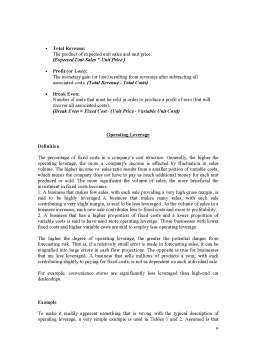Cuprins
- Introduction page 3
- Contribution margin analysis page 3
- Breakeven analysis page 6
- Operating leverage analysis page 10
- Conclusion page 15
- Bibliography page 16
Extras din referat
Cost Volume Profit Analysis
To have a strong and successful business, you need to have a clear understanding of the financial impact that your most basic business decisions may have.
For example, do you know what your most profitable products or services are, so that you (or your salespeople) can really push those? Do you know what will happen if your sales volume drops? How far can it drop before you really start to eat red ink? If you lower your prices in order to sell more, how much more will you have to sell? If you take out a loan and your fixed costs rise because of the interest on the loan, what sales volume will you need to cover those increased costs?
Cost/volume/profit analysis can help you answer these, and many more, questions about your business operations. CVP analysis, as it is sometimes known, is a way of examining the relationship between your fixed and variable costs, your volume (in terms of units or in terms of dollars), and your profits.
There are three main tools offered by CVP analysis:
- breakeven analysis, which tells you the sales volume you need to break even, under different price or cost scenarios
- contribution margin analysis, which compares the profitability of different products, lines, or services you offer
- operating leverage, which examines the degree to which your business uses fixed costs, which magnifies your profits as sales increase, but also magnifies your losses as sales drop.
Contribution Margin
One of the important, yet relatively simple, tools afforded by cost/volume/profit analysis is known as contribution margin analysis.
In simplest terms, the contribution margin is total revenue minus total variable cost. This difference can be expressed as a percentage of total revenue. A company's contribution margin can be expressed as the percentage of each sale that remains after the variable costs are subtracted. Given the contribution margin, a manager can make better decisions about whether to add or subtract a product line, about how to price a product or service, and about how to structure sales commissions or bonuses. The contribution margin is computed using a special type of income statement that has been reformatted to group together a business's fixed and variable costs.
Your company's contribution margin is simply the percentage of each sales dollar that remains after the variable costs are subtracted. . The phrase "contribution margin" can also refer to a per unit measure of a product's gross operating margin, calculated simply as the product's price minus its total variable costs.
How is your contribution margin computed? By using a special type of income statement that has been reformatted to group together your businesses fixed and variable costs.
Here's an example of a contribution format income statement:
Preview document
Conținut arhivă zip
- Cost-Volume-Profit Analysis.doc


























